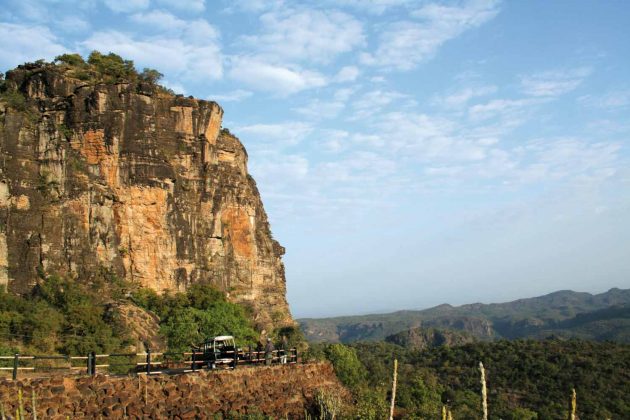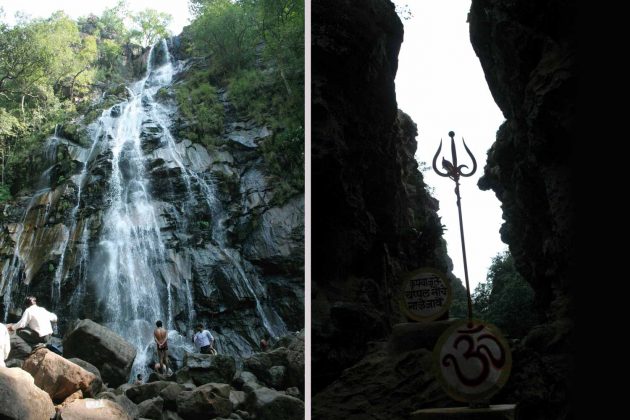Blame it on the soft rays of sunlight that filtered though the branches of the fragrant mahua trees, or on the sweet, cool water I had just drunk from the bountiful waterfall… but I was stupefied. And this was just 10 minutes into my tryst with Pachmarhi.
I was fresh off my 14-hour, uneventful drive from Delhi, as I drove across dusty roads, flanked with verdant cornfields and a powder blue autumn sky above. I could have flown into Bhopal and then driven another 210 km up to Pachmarhi. But, there is something about a road trip that gets me all adventurous and raring to go.
As the only hill station in Madhya Pradesh, straddling the Satpuras at 3,500 feet above sea level, Pachmarhi is bestowed with oodles of beauty and charm. No wonder wounded and sick British army men chose this paradisiacal haven to convalesce in, when it was a sanatorium town during the Raj. Evidence of its British past can be seen at places such as the Christ Church with its stunning stained glass windows constructed in 1875. The Bison Lodge is another such relic. A part of Captain James Forsyth’s [who established Pachmarhi in 1857] legacy and built in 1862 as Pachmarhi’s first forest lodge, Bison Lodge is today a museum dedicated to the area’s flora and fauna. Interestingly, it also bears the distinction of being Pachmarhi’s oldest building.
But delving a little deeper into Pachmarhi’s history unearths another more ancient past. It is believed that the hill station gets its name from the Pandav Caves, which is where the Pandavas from the Mahabharata lived during their exile. Speaking of caves, there are a whole host of breathtaking masterpieces to set your sights on. While the Mahadeo Cave leading up to the Shiv Shrine at the Chauragarh Temple is one of the most popular, the Jatashankar Cave with its stalagmites is no less well-visited. The day I was there, a group of trigger-happy Japanese tourists couldn’t get enough pictures of the devotees taking dips in the sacred Jambu Dweep pond alongside the cave.
Pachmarhi offers an adequate range of comfortable accommodation options to suit every budget. I was booked into the plush Rock-End Manor—a jewel of a hotel that is next door to the Army Golf Course. Built in 1905, the hotel is famous for its spacious rooms and generous verandas from where one can see the emerald slopes of the hills meet the placid valley below in a warm hug!
On my last morning, after wolfing down a plate of steaming puri-bhaji, washed down with a tall glass of refreshing nimbu paani [that Pachmarhi is also famous for] at Raj Bhoj off Patel Road, I decided to end my Pachmarhi soujourn with a visit to the Big Fall or Rajat Prapat that snakes its way down a treacherous cliff, creating a gossamer veil of perpetual mist—a sight that you won’t forget in the days that follow your visit to Pachmarhi. Months even. Ask me…
Best of Bhimbetka
An über scenic two-hour drive from Pachmarhi will bring you to the UNESCO World Heritage Sight of Bhimbetka that is a virtual treasure trove of prehistoric rock art, believed to be at least 12,000 years old. The rock paintings here are mostly of animals and of village life done in pigment rich colours of red and white that are as vivid and mesmerising today as they probably were when first painted. Simply magical.
Wild Business
Listen up all you wildlife buffs out there! To get a glimpse of some awesome fauna including elephants, gaur, chinkara and a plethora of bird species, head out to the Satpura National Park whose Madhai Gate is a 100km drive from Pachmarhi. Here, you can opt for either the MPTDC [Madhya Pradesh Tourism Development Corporation] -run Gypsy safaris or the elephant safaris. Better still; simply go at it on your own.
Oh, Honey!
The association of honey and Pachmarhi is so old that many of its caves feature rock paintings depicting the collection of honey. No great surprises then, that the purest organic honey can be sampled and bought here. The Chunmun Cottage shop is one of the best places in Pachmarhi to pick up yummy varieties of the precious amber-hued nectar.
This was first published in the October 2013 issue of Complete Wellbeing.





